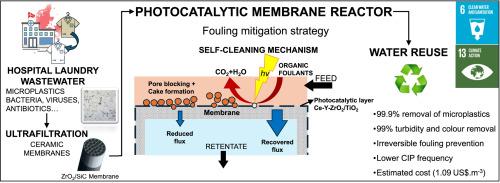Microplastics removal from a hospital laundry wastewater combining ceramic membranes and a photocatalytic membrane reactor: Fouling mitigation, water reuse, and cost estimation
IF 8.4
1区 工程技术
Q1 ENGINEERING, CHEMICAL
引用次数: 0
Abstract
The release of microplastics (MPs) through industrial laundry wastewater accounts for 35 % of global MPs emissions into the environment and it is a significant environmental problem, especially because MPs can absorb contaminants of emerging concern (CECs) from garments. This study is the first to evaluate and perform a cost estimation of the MP removal from hospital laundry wastewater (HLWW) using a combination of ceramic membranes and a pilot-scale photocatalytic membrane reactor (PMR) as a fouling mitigation strategy. The HLWW, from a hospital in Copenhagen, Denmark, contained a total organic carbon (TOC) of 345 mg L⁻1 and 1.4 × 106 MP L−1, mainly of polyethylene terephthalate (PET) ranging between 100 and 200 μm in size. The pre-treatment with an ultrafiltration (UF) ZrO₂ membrane successfully removed 96 % of MPs and over 98 % of suspended solids and turbidity at an estimated cost of 0.45 US$ per m3 of permeate. In the PMR stage, ultraviolet light emitting diodes (UV LED) irradiation reduced irreversible fouling, improving permeate flow and minimizing the need for chemical cleaning. The Ce–Y–ZrO2/TiO2 photocatalytic membrane achieved over 99 % removal of turbidity, colour, and suspended solids, as well as 99.9 % removal of MPs, allowing the potential effluent reuse within the hospital laundry. Additionally, the retentate from the PMR process had lower TOC, easing the discharge of this concentrated stream. The cost estimation demonstrated that the photocatalytic degradation combined with traditional techniques, i.e. backflush and chemical cleaning, is more economical than using these techniques separately. Therefore, the total treatment cost was 1.09 US$ per m3 of permeate, which is lower than the cost of fresh water in Denmark. In conclusion, this innovative treatment strategy offers a sustainable and cost-effective solution for HLWW management, not only reducing water consumption by enabling water reuse in the hospital laundry but also advances towards achieving net-zero liquid discharge and contributing to the UN Sustainable Development Goals for clean water (Goal 6) and climate action (Goal 13).

结合陶瓷膜和光催化膜反应器去除医院洗衣废水中的微塑料:污垢缓解、水回用和成本估算
微塑料(MPs)通过工业洗衣废水排放到环境中,占全球 MPs 排放量的 35%,是一个重大的环境问题,特别是因为 MPs 可以吸收服装中新出现的污染物(CECs)。本研究首次使用陶瓷膜和中试规模的光催化膜反应器(PMR)组合作为污垢缓解策略,对医院洗衣废水(HLWW)中 MP 的去除进行评估和成本估算。来自丹麦哥本哈根一家医院的 HLWW 含有 345 mg L-1 的总有机碳 (TOC) 和 1.4 × 106 L-1 的 MP,主要是尺寸在 100 到 200 μm 之间的聚对苯二甲酸乙二酯 (PET)。使用超滤 (UF) ZrO₂ 膜进行预处理,成功去除 96% 的 MPs 和 98% 以上的悬浮固体和浊度,每立方米渗透液的成本估计为 0.45 美元。在 PMR 阶段,紫外线发光二极管(UV LED)的照射减少了不可逆污垢,提高了渗透流量,最大限度地减少了化学清洗的需要。Ce-Y-ZrO2/TiO2 光催化膜对浊度、色度和悬浮固体的去除率超过 99%,对 MPs 的去除率也达到 99.9%,因此有可能在医院洗衣房内实现污水回用。此外,PMR 工艺的回流液总有机碳含量较低,从而简化了这一浓缩流的排放。成本估算表明,光催化降解与传统技术(即反冲洗和化学清洗)相结合,比单独使用这些技术更经济。因此,每立方米渗透液的总处理成本为 1.09 美元,低于丹麦的淡水成本。总之,这种创新的处理策略为 HLWW 管理提供了一种可持续的、具有成本效益的解决方案,不仅通过在医院洗衣房实现水的再利用减少了用水量,还推动实现了液体净零排放,为联合国可持续发展目标中的清洁水(目标 6)和气候行动(目标 13)做出了贡献。
本文章由计算机程序翻译,如有差异,请以英文原文为准。
求助全文
约1分钟内获得全文
求助全文
来源期刊

Journal of Membrane Science
工程技术-高分子科学
CiteScore
17.10
自引率
17.90%
发文量
1031
审稿时长
2.5 months
期刊介绍:
The Journal of Membrane Science is a publication that focuses on membrane systems and is aimed at academic and industrial chemists, chemical engineers, materials scientists, and membranologists. It publishes original research and reviews on various aspects of membrane transport, membrane formation/structure, fouling, module/process design, and processes/applications. The journal primarily focuses on the structure, function, and performance of non-biological membranes but also includes papers that relate to biological membranes. The Journal of Membrane Science publishes Full Text Papers, State-of-the-Art Reviews, Letters to the Editor, and Perspectives.
 求助内容:
求助内容: 应助结果提醒方式:
应助结果提醒方式:


